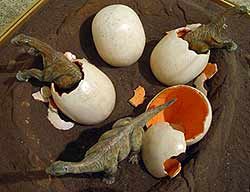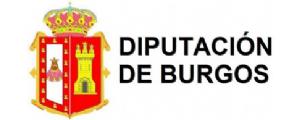In this room you enter the fascinating world of dinosaurs and probably will be surprised by the great quantity and variety of fossil remains of these animals that rule in the past ages.
 Many pieces have a great scientific value and some of them are unique in the world.
Many pieces have a great scientific value and some of them are unique in the world.
The collection of dinosaur fossils in the Museum in Salas de los Infantes is one of the most complete in Spain.
Various, easy-to-follow informative boards illustrate the geological history of the area and show the different fossils found in surrounding outcrops.
A life-size wall illustration shows an Iguanodon, a peaceful and herbivorous dinosaur that wandered, in groups, about the banks of the big fluvial system that crossed this area 120 million of years ago. Various bones of this dinosaur, which was more than eight metres long and four meters tall, are exposed. Some of them are included in a model that illustrates an excavation of dinosaur fossils.
There are several remains of the herbivorous Hypsilophondonts. Remarkable slenderness of body and extremities indicate that these were agile runners.
There are the defensive spines of an armoured dinosaur called Polacanthus, rarely found in Europe.
Huge bones of Sauropods include: vertebrae, remains of of huge spinal column, extremities and teeth. They are fine examples of well-known giants such as Diplodocus or the Brachiosaurus.
Sharp, dagger-like teeth like daggers and very fine teeth come from dinosaurs such as Megalosaurus, Baryonyx or carcharodontosaurid allosauroids.
 Amongst all the pieces that form the exhibition, the most surprising ones could be the fossil eggs of dinosaurs. It is an incredible fossilization miracle that something so fragile can survive today after being laid by a dinosaur many, many millions of years ago. A part of a nest is exposed, and also a whole egg probably from the same age. They have been attributed to Titanosaurids and Sauropods about 20 meters long that built their nests in large colonies on the banks of lakes and rivers. Next to the eggs there is a model that recreates with great realism the precise moment when Titanosaurus babies emerged, 65 million of years ago.
Amongst all the pieces that form the exhibition, the most surprising ones could be the fossil eggs of dinosaurs. It is an incredible fossilization miracle that something so fragile can survive today after being laid by a dinosaur many, many millions of years ago. A part of a nest is exposed, and also a whole egg probably from the same age. They have been attributed to Titanosaurids and Sauropods about 20 meters long that built their nests in large colonies on the banks of lakes and rivers. Next to the eggs there is a model that recreates with great realism the precise moment when Titanosaurus babies emerged, 65 million of years ago.
Dinosaurs were not alone during their long reign. Other animals lived under their supremacy. The museum shows remains of crocodiles, turtles and fish that comprised the Mesozoic fauna in the surroundings of Salas.
There are also excellent fossils of plants that lived during the age of the dinosaurs. They include trunks of tree brackens, palm ferns and fragments of conifers, remains of the luxuriant subtropical plant forests where the dinosaurs lived and bred.
In the centre of the room a model recreates the landscape that once surrounded Salas de los Infantes. It shows how the dinosaurs, whose remains are exposed in the museum, lived on the banks of a large river, along with contemporary animals and plants.






